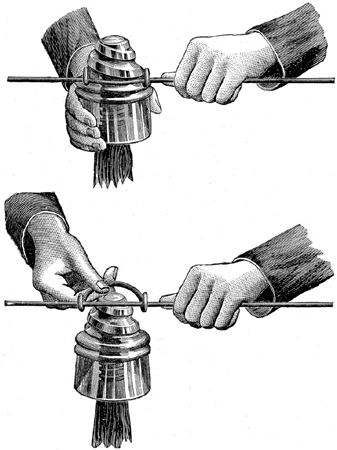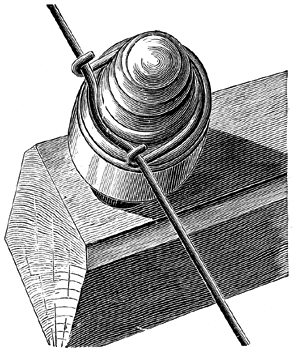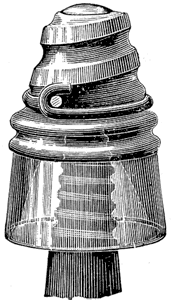[Trade Journal]
Publication: Electrical Review
New York, NY, United States
vol. 6, no. 26, p. 6, col. 3-4
The National Self-Binding Insulator.
This insulator, which is coming into particular favor with telephone and telegraph people, is now controlled in the United States by Messrs. Lytle & Co., of this city. The American Bell Telephone Company have decided to adopt them for their long line work, and other local companies are using them with very satisfactory results. This insulator is the invention of J. Slater Lewis, of England, and is being extensively used in Europe. It dispenses entirely with the old and troublesome tie-wire, being so constructed that the line-wire is applied and secured without the use of any tools whatever, and in the shortest possible time. It can be used in any situation, whether on curves, against walls, under bridges, on roofs, or wherever a tie-wire can be used. It is remarkably simple, durable and efficient, and may be removed or renewed with the greatest facility. It is constructed with a conical and expanding screw-thread upon the exterior of the upper portion, similar in form and principle to the point of a gimlet. The line-wire is attached by means of a rigid wire shackle or clip, formed in the shape of a horseshoe, the curved portion of which is adapted to encircle the body of the insulator at the base of the conical screw portion, while each end of the clip is made into a hook adapted to grasp the line-wire. The bell of the insulator below the point of support of the line is given the form shown by experience to be the best.
Besides the peculiar form of attachment for the wire, the National Insulator is provided with a perfect internal screw. It is formed by newly-invented molding tools of peculiar form; the greater sharpness and accuracy of the thread gives a better hold to the pin, and facilitates the operation of securing the insulator both to the main line and to the support.
 |
| Figs. 1 and 2. — Method of Placing Wire on National Screw-Top Insulator. |
The figures 1 and 2 show the position of the clip and line-wire when applied to the insulator.
 |
| Fig. 3. — Position of Line Wire When Applied to Insulator. |
The insulator having been screwed on the bracket or pin, give it three complete turns backwards after it has come to its bearing, and hook the clip on the line wire with the ends of the hooks turned upwards, as shown in Fig. 3, then drop the clip and line wire over the top of the insulator as shown in the same figure, after which the insulator must be screwed down on the pin as shown in Fig. 4. Care must be taken to see that the clip goes down the thread of the screw first with the line wire following it, the screwing motion being continued until the insulator comes to its bearing on the pin or bracket, when the attachment will be complete.
 |
| Fig. 4. — Showing Position of Clip. |
It will be seen that the insulator is secured to the pin or bracket, as well as to the line wire, by a single operation. In detaching the line wire this process is exactly reversed, the insulator is turned the other way, the line wire going up by the groove first and the clip following, Some linemen prefer to carry a pocket oil can, and before screwing on the clip they apply a single drop to the point on the clip, and also on the line wire which rubs against the insulator; friction is thereby avoided and the work made easier.
 |
| Fig. 5. — Method of Replacing Broken Insulator. |
To replace a broken or damaged insulator of the common kind, it must be smashed and the pieces taken out, leaving the tie-wire attached to the line as shown in Fig. 5. The new insulator is then screwed on the pin or bracket as before, and the loop placed over the top of it, after which the operation is precisely the same as illustrated in Figs. 3 and 4. After a little practice the attachment may be made with great rapidity.
